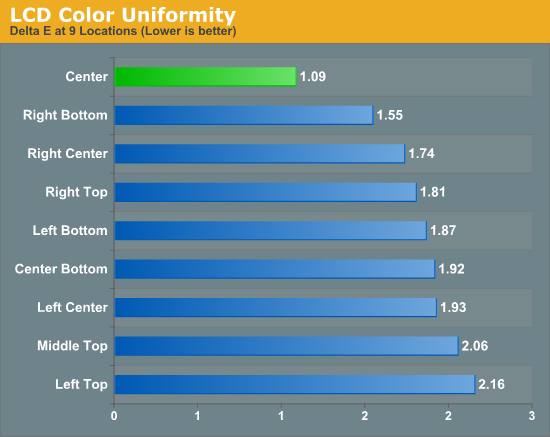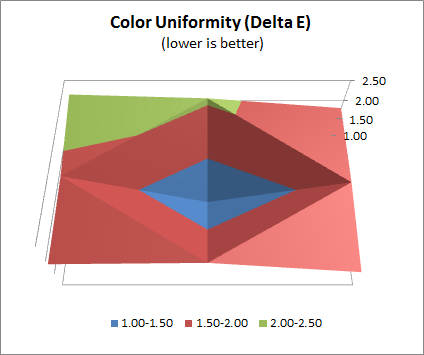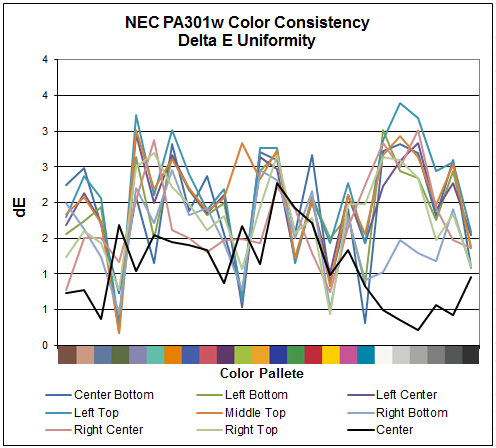NEC PA301w: The Baddest 30-inch Display Around
by Brian Klug on March 1, 2011 8:00 AM ESTColor Consistency
Now for color consistency, we take our best calibration profile from the very center at 200 nits and test color accuracy at 9 different places around the LCD display in an evenly distributed grid. We’ve shown before that calibration is actually very localized across the display, partly due to the brightness not being uniform, partly due to the discrete nature of the LCD panel itself.


If you go back and compare to the other 30-inchers, you'll discover that the PA301w is narrowly edges out the HP ZR30w and has a clear advantage over the Dell U3011. Interestingly enough, the PA301w has a uniformity setting inside the OSD which defaults to 5 (maximum) and seems to definitely improve overall brightness uniformity and Delta-E consistency. Whatever secret sauce NEC has apparently works.











92 Comments
View All Comments
bossanova808 - Thursday, March 3, 2011 - link
Having tested this in practise, the 'working quite well' in practice means glitchy as anything. Half the tools don't work properly in terms of rendering around the cursor...if you more thoroughly browse Chris's comments on it in the PS forums, you'll see he acknowledges this.SanX - Tuesday, March 1, 2011 - link
Must be 4K for $2K.Only 100 DPI, or 184 implied DPI ? For $2K ? I see every pixel on it
Griswold - Wednesday, March 2, 2011 - link
Dont talk about things you dont understand, please.bossanova808 - Tuesday, March 1, 2011 - link
Hi FolksIf you're going to start commenting on colour accurate monitor like the NEC PA series or the Eizo CG series, you're going to need to seriously step up both your knowledge and methodology I'm afraid.
You should probably provide a caveat in this review, as the whole colour and uniformity section is pretty much flat out wrong.
For starters, your ED2 is simply not the right sensor to use with sort of monitor - designed quite some years ago now, it's simply incapable of reading the wider gamuts of modern displays accurately. Essentially any other sensor would do better - the Eye One Pro is the obvious choice for you guys I'd say, but really a Munki, Spyder3 or similar would be a better starting point. This has probably lead to the likely very erroneous reading of 5600K for the from factory whitepoint - almost all the PAs seem to come out of the factory bang on 6500K when properly tested. The ED2 is absolutely crap at measuring the primaries on monitors like these.
The NEC sensor has tweaked filters to cope with these monitors and does a much better job but you probably need a general purpose solution like the Eye One Pro.
Further, for calibration, this monitor is crying out to be used with SpectraView2 which is NEC's direct hardware calibration software that can directly manipulate the 14 bit monitor LUTs. Basically, not using this software is kind of defeating the point of using a display like this.
You might want to contact Will Hollingsworth at NEC Colour Critical Displays to have a chat and see if you can't re-visit some of this testing with better methodology & equipment.
eaw999 - Wednesday, March 2, 2011 - link
agreed 100%.bossanova808 - Wednesday, March 2, 2011 - link
...basically, the Mac can't do 10 bit right now (confirmed by both Apple and Adobe), and while the PC has 10 bit support int he OS and it generally works, there are some big issues - Aero effects gets turned off, and apps that sort of support 10 bit like Photoshop have some big glitches still (you can see PS render an 8 bit working square around the cursor with some of the tools that aren't 10 it ready!) - most likely Win8 and Photoshop CS6 will be where 10 bit really comes in to play.softdrinkviking - Wednesday, March 2, 2011 - link
and when 10 bit color finally "comes into play," is it really going to make much of a difference?or should i say, will most people even be able to tell the difference?
DanNeely - Wednesday, March 2, 2011 - link
Probably nto much. The main benefit will likely be being able to render images marked as sRGB on an extended gamut display without banding or over saturation problems.bossanova808 - Thursday, March 3, 2011 - link
Err, dan that isn't right. sRGB rendering on the PA series is already remakrably good and there's no banding issues. The over saturation issues come mainly from non CM stuff, particularly OS elements and the like, that are sent as raw RGB numbers and thus appear quite oversaturated. I think you'll see UI designers tone down the colour going forward...The main benefit will most likely be considerably better control of colour in deep shadows.
softdrinkviking - Wednesday, March 2, 2011 - link
Thanks for the response...This is what I could dig up for the community, or any curious bystanders...
First of all, NEC just redid their whole website like yesterday! so I can't find exactly the same info I was referring to.
But... here is an excerpt from the FAQ for the Spectraview2 software...
" Which is better: a colorimeter or spectrophotometer such as the X-Rite iOne Pro?
In general a spectrophotometer provides more accurate color measurements than a "generic" colorimeter does when measuring most displays. However a colorimeter can be specifically calibrated against a lab grade instrument to match a particular type of display, and thus provide extremely accurate color measurements. This approach was taken with the new custom-calibrated X-Rite iOne Display V2 included in the Display Calibration Bundle.
A spectrophotometer can suffer from drift and low luminance noise issues that can cause problems—specifically when measuring and calibrating near black. In general colorimeters provide superior low luminance measurements than spectrophotometer."
So a couple of interesting things are said here. 1. Colorimeters can be better than uber-expensive spectrophotometers in certain metrics and 2. That NEC specifically calibrates their version of the x-rite meter to compensate for the shortcomings of the colorimeter process.
So, if NEC is to be believed, you need an NEC branded meter to achieve better than so-so results from a generic colorimeter.
here's the link to that, split-up, if you wanna see for yourself...
http:// necdisplay. com /support-and-services/spectra-view-II/FAQ